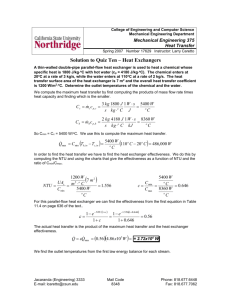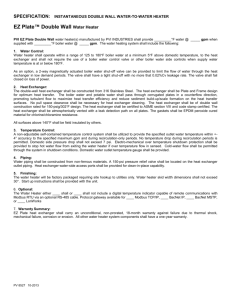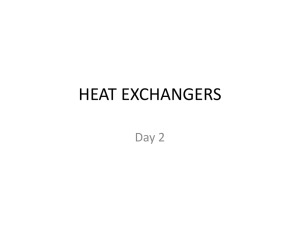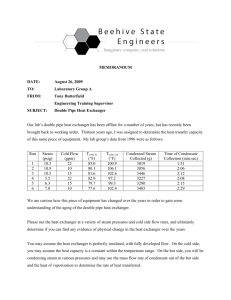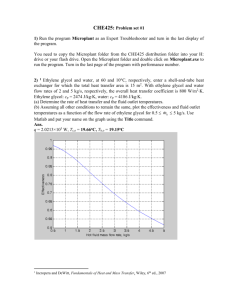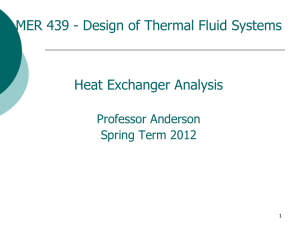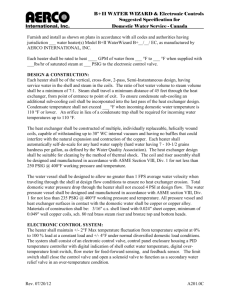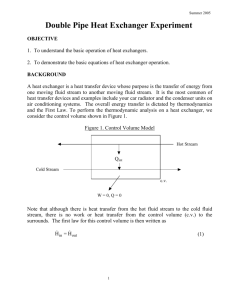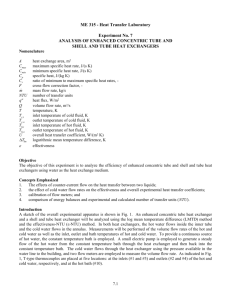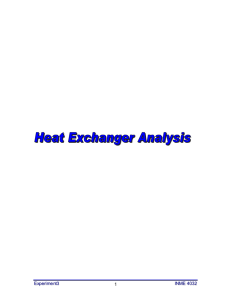Forced Convection Heat Transfer from 3D Solids Experiment
advertisement
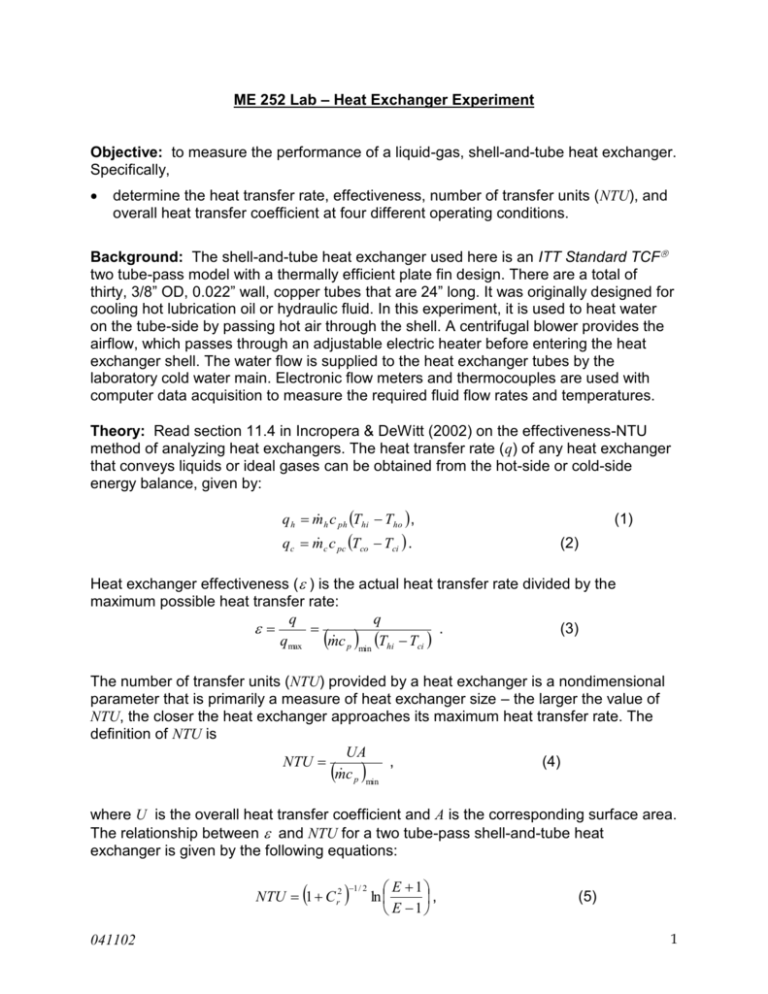
ME 252 Lab – Heat Exchanger Experiment Objective: to measure the performance of a liquid-gas, shell-and-tube heat exchanger. Specifically, determine the heat transfer rate, effectiveness, number of transfer units (NTU), and overall heat transfer coefficient at four different operating conditions. Background: The shell-and-tube heat exchanger used here is an ITT Standard TCF two tube-pass model with a thermally efficient plate fin design. There are a total of thirty, 3/8” OD, 0.022” wall, copper tubes that are 24” long. It was originally designed for cooling hot lubrication oil or hydraulic fluid. In this experiment, it is used to heat water on the tube-side by passing hot air through the shell. A centrifugal blower provides the airflow, which passes through an adjustable electric heater before entering the heat exchanger shell. The water flow is supplied to the heat exchanger tubes by the laboratory cold water main. Electronic flow meters and thermocouples are used with computer data acquisition to measure the required fluid flow rates and temperatures. Theory: Read section 11.4 in Incropera & DeWitt (2002) on the effectiveness-NTU method of analyzing heat exchangers. The heat transfer rate (q) of any heat exchanger that conveys liquids or ideal gases can be obtained from the hot-side or cold-side energy balance, given by: q h m h c ph Thi Tho , qc m c c pc Tco Tci . (1) (2) Heat exchanger effectiveness ( ) is the actual heat transfer rate divided by the maximum possible heat transfer rate: q q . (3) qmax m c p min Thi Tci The number of transfer units (NTU) provided by a heat exchanger is a nondimensional parameter that is primarily a measure of heat exchanger size – the larger the value of NTU, the closer the heat exchanger approaches its maximum heat transfer rate. The definition of NTU is UA (4) NTU m c p min , where U is the overall heat transfer coefficient and A is the corresponding surface area. The relationship between and NTU for a two tube-pass shell-and-tube heat exchanger is given by the following equations: NTU 1 C r2 1 / 2 041102 E 1 ln , E 1 (5) 1 E 2 / 1 Cr Cr 1 C 2 1/ 2 r m c m c p min , (6) . (7) p max Apparatus and Instrumentation: ITT Standard TCF heat exchanger Variac-controlled centrifugal blower Variac-controlled electric heater with three ranges Glass tube rotameter for air Totalizing turbine water meter Precision needle valve for water flow control Omega FTB936 pulse-output turbine air flow meter Omega FTB4607 pulse-output turbine water flow meter Two Omega DPF700 ratemeters with analog output Eight K-type thermocouples Omega DP119 miniature panel thermometer Fluke Hydra Data Logger with PC and software Safety glasses Testing Conditions: Air Flow Rate (lpm) 500 500 1000 1000 Water Flow Rate (lpm) 5 10 5 10 Heater Setting Range 3, 50% Range 3, 50% Range 3, 50% Range 3, 50% Thermostat Set Pt. 200F 200F 250F 250F Procedure: 1. Connect the garden hose to the water inlet and make sure that the exit hose drains into the floor trough. Make sure the heater rheostat is in the “off” position. Plug in power cord. 2. Set up computer data acquisition system and make sure all thermocouples are reading correct temperature values. Set up the Fluke Hydra data logger with a sampling interval of 10 sec and enable data recording to a named file with an Elapsed Time tag and Append mode. Enable the Quick Plot feature to monitor all temperatures and flow rates. 3. Turn the water gate valve at the supply spigot to the fully open position. Adjust the needle valve to yield the correct water flow rate for the given testing condition. Turn 041102 2 4. 5. 6. 7. 8. 9. on the blower and adjust the speed rheostat to yield the correct airflow rate for the given testing condition. Check to make sure that the data logger is reading the correct flow rates. Always make sure that there is water and air flowing through the heat exchanger before turning on the electric heater. Adjust the heater rheostat for the given testing condition. Record data until steady-state temperatures are reached; this will require about 15 minutes from a cold start. Run heat exchanger for about 2 minutes at “steady-state”. Stop the data logger and adjust the flow rates and heater for the next testing condition. Resume data logging. Repeat steps 5-6 for all four testing conditions. Turn off the heater at the end of the experiment, but keep the blower and water flow on for about 10 minutes to cool down the electric heater core and heat exchanger. Have a 3.5” diskette available for downloading your data files. Be sure to identify each channel number with the measured quantity. Results: Average the steady-state data (approx. 10-12 readings) for each testing condition. Show the steady-state data and averages in a separate worksheet. Perform the required calculations and complete a summary table as shown below. Be sure to use the blower inlet temperature to compute the air density for the air mass flow rate calculation. Clearly present all data reduction with sample hand calculations. Be sure to show all material property evaluations (, cp). Summary of Results Air Mass Flow Rate m h (kg/s) Water Mass Flow Rate m c (kg/s) Thi (C) Tci (C) qh (W) qc (W) (%) NTU Uc (W/m2-K) Note: In theory, qh and qc should be identical if no heat loss from the heat exchanger to the surroundings occurs. In practice, however, this is not the case due to some heat loss and measurement errors in flow rate and temperatures. When calculating , use qh for the actual heat transfer rate since it will produce less uncertainty for two reasons: i) the air experiences a greater temperature difference between inlet and exit than the water, and ii) any errors in the measured air flow rate will cancel in equation (3). 041102 3 Questions: 1. Which flow rate (water or air) has the greatest effect on the heat transfer rate? Explain why. 2. How would you rate the effectiveness () of this heat exchanger? What trends, if any, do you observe in the effectiveness as a function of the water or airflow rate? 3. Suppose the hot-side fluid was engine oil instead of air. If the oil had the same mass flow rate and inlet temperature as the air, what differences would you see, if any, in the calculated heat transfer rates, effectiveness, NTU, and cold-side overall heat transfer coefficient (Uc) ? 041102 4
